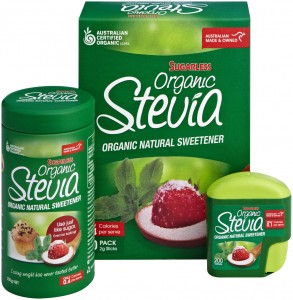
The Australian brand Organic Stevia
Plant-derived sweetener stevia has been quietly gaining traction with consumers and usurping the traditional pecking order of more established sweeteners, according to a new report from market research organisations Mintel and Leatherhead Food Research (Leatherhead).
While the value of stevia as an additive for use in food and beverage manufacture totalled US$110 million in 2013, Mintel and Leatherhead forecast this to grow to US$275 million by 2017. In contrast, aspartame — while recently having been ruled safe for human consumption at current levels from the European Food Safety Authority (EFSA) and currently accounting for a value of £280 million in 2013 — is forecast to drop to £210 million by 2017 as stevia, and blends of stevia and other sweeteners such as acesulfame K, begin to take a greater share of the market.
Plant-derived sweeteners gaining popularity
In 2009, only 5 per cent of food and drinks products launched using intense sweeteners used solely plant-derived sweeteners (although a further 2 per cent used a blend of artificial and plant-derived sweeteners). In contrast, in 2013 the share of plant-derived sweeteners jumped to 15 per cent (with a further 3 per cent using a blend of artificial and plant-derived sweeteners). Between 2011 and 2013, plant-derived sweeteners reached a high of 28 per cent of launches in North America.
“Much of the growth in the global sweeteners market is set to be driven by growing consumer concerns over sugar intake, whilst the development of more plant-derived sweeteners is also anticipated to benefit the market,” said Laura Jones, Food Science Analyst at Mintel.
“The gradual demise of sugar yet desire for sweetened food and drink products suggests good opportunities for intense sweeteners,” Ms Jones said. “Intense sweeteners offer a source of sweetness without the calorie contribution of sugar, an increasingly attractive proposition to consumers struggling to manage their weight,” she said.
“Signs that the global market for intense sweeteners has reacted to this increased demand for ‘healthier’ sweetener solutions is already evident,” Ms Jones said.
By the end of 2013, the global market for intense sweeteners as additives used the the manufacture of food and beverage products is forecast to reach a value of US$1.27 billion — a figure that represents an increase of 2.8 per cent compared with 2012. By 2017, global market value is expected to increase to almost US$1.4 billion, up by 9.7 per cent from levels in 2013.
Artificial sweeteners still dominate intense sweetener sector
However, breaking down the usage of intense sweeteners in new product launches showed that currently, artificial variants, such as acesulfame-K, sucralose and aspartame are still dominant, according to Mintel and Leatherhead.
Due to its use in blends, acesulfame-K leads in launch activity, however, the share of products using acesulfame-K had gradually declined from 56 per cent in 2009 to 49 per cent of launches in 2013. Sucralose took the second spot and its use remained constant over the past five years, found in around 40 per cent of all products launched with an intense sweetener.
Aspartame comes in next, however, its share was consistently dropping year on year, going from being used in 40 per cent of 2009 launches to 32 per cent of 2013 launches. Categories still heavily reliant on artificial variants include sugar confectionery, desserts and ice cream, dairy products and carbonated soft drinks.
“Plant-derived sweeteners, such as stevia, are expected to provide the main impetus for growth in the sweetener market in the coming years,” said Emma Gubisch, Strategic Insight Manager at Leatherhead Food Research. “As manufacturers work to create the right taste profile for steiva and for other plant-derived sweeteners, such as monk fruit, to obtain regulatory clearance, the artificial sweetener market still offers growth opportunities, in particular in the sucralose and acesulfame-K markets,” she said.
Sucralose the largest sector
Sucralose was the largest sector within the global intense sweeteners market in value terms (34 per cent), having overtaken aspartame in recent years. Mintel and Leatherhead said it showed “more potential for growth” in some regions because of its positioning as the most “sugar-like” of the artificial sweeteners.
Growth of intense sweeteners in food and drinks set to continue
The use of intense sweeteners in launches of food and drink products has grown over the past five years, from being used in 3.5 per cent of all launches globally in 2009 to 5.5 per cent in 2012, and this growth looks sets to continue.
Meanwhile, the global market for all sweeteners (intense and bulk) as additives in food manufacture — rather than sold to consumers at the retail level — was worth more than US$2 billion in 2012. Value sales started to pick up again as the worldwide economic situation improved, with the global market up by 3.8 per cent from US$1.94 billion in 2010.





